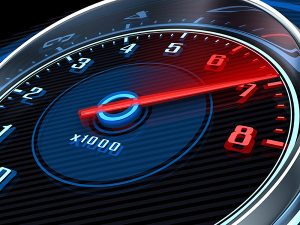Everyone knows about how quick battery-powered devices are – because it’s the one appealing thing battery-powered devices can tout about themselves vs. other cars. It is not a stretch to say that quickness is the thing that’s been used to get people focused on as desirable rather than the undesirability of how long it takes to get a battery powered device going again once it has run out of charge.
But did you know that battery powered devices are slow?
Meaning, they are not very fast.
Yes, they accelerate quickly – initially. They tout super-quick 0-60 times. But they slow down remarkably after that.
Try it yourself and see.
Most EVs – including “performance” models – have top speeds in the neighborhood of 130 MPH, which isn’t very fast at all. A Prius is capable of going that fast; it just takes awhile to get going that fast. A four cylinder powered Camry is also that fast. Just about any late-model car is capable of going that fast.
It was no always so – chiefly because in the past most cars lacked the leverage (rather than the power) to go that fast. Very few of the V8 powered muscle cars of the ’60s and ’70s had top speeds much faster than 130 MPH – if they were able to go even that fast. Many of them were close to their maximum speed at around 115-120 MPH because of their gearing.
More finely, their lack of overdrive gearing.
The typical V8 powered muscle car had either a four speed manual transmission or a three speed automatic and neither of them had overdrive. Their top gear (fourth or third) had a 1:1 ratio, which meant that when paired up with an aggressive final drive ratio (the ring and pinion gear in the rear axle, which was typically something like 3.23 or even 4:11) you had a mechanically limited top speed that was not very fast. The engine would be at or near its redline at speeds a new Prius can achieve, even though the muscle car’s engine was twice or even three times as powerful.
A modern muscle car such as the recently force-retired (due to compliance pressures and corporate cowardice) Dodge Challenger could easily exceed 130 MPH because it had both the power and the gearing. Many modern luxury-sport sedans have top speeds of 155 MPH and could go faster. They are electronically limited to no faster than 155 – often because their manufacturers are worried about legal liability or because the cars are not equipped with high-speed tires rated to handle speeds faster than 155 MPH.
Battery-powered devices, on the other hand, are slowed down by their weight. The heavier a vehicle is, the harder it is to make it go fast. And battery-powered devices are much heavier than comparable in size cars.
A Tesla Model 3, for instance, is about the same size as a Toyota Prius. The latter is 181.1 inches long; the former is 185.8 inches long. But the only slightly longer Tesla weighs nearly 800 pounds more (3,891 lbs. vs. 3,097 lbs.). Most of that being the weight of the device’s much larger battery pack. An even less favorable – to the device – comparison would be vs. a small sedan such as the Honda Civic, which is also about the same size as the device (184.8 inches long, so almost exactly the same size) but weighs just 2,877 lbs. because the only battery it’s lugging around is the one that starts its engine.
And that one weighs about 50 lbs.
That’s why the Civic weighs 1,014 lbs. less than the Tesla 3 device and it’s why the Tesla 3 device isn’t any faster than the Civic – even though it is much quicker. They both “top out” at about 130 MPH even though the Tesla device is much more powerful. The Civic can get to 130 MPH with just 180 horsepower. The Tesla 3 needs 394 horsepower (dual motor set-up) to achieve the same speed – though it is much quicker getting to 60 (just over 4 seconds) than the Civic, which needs about 7.4 seconds to make the same run.
There are a few devices that are both quick and fast – such as the Tesla Model S Plaid. It has 1,020 horsepower – which is the kind of power needed to push 4,776 lbs. of battery powered device to 200 MPH. A Dodge Challenger Hellcat is just as fast but only needs 717 horsepower to go just as fast because it weighs only 4,430 lbs.
Put another way, the heavier you are, the slower you go.
There is no such thing as a free lunch, in other words – in physics or on the road!
. . .
If you like what you’ve found here please consider supporting EPautos.
We depend on you to keep the wheels turning!
Our donate button is here. We also accept crypto (see below).
If you prefer not to use PayPal, our mailing address is:
EPautos
721 Hummingbird Lane SE
Copper Hill, VA 24079
PS: Get an EPautos magnet or sticker or coaster in return for a $20 or more one-time donation or a $10 or more monthly recurring donation. (Please be sure to tell us you want a magnet or sticker or coaster – and also, provide an address, so we know where to mail the thing!)
If you like items like the Baaaaaa! baseball cap pictured below, you can find that and more at the EPautos store!

The bitcoin code is: 3GAfymoqSUbaFvY8ztpSoDKJWCPLrkzAmi if you’re unable to scan the QR code above!











The first Road & Track I ever bought was in 1973. It had an MGTC and Ferarri Daytona on the cover. The test of the Ferarri had a picture of the dash showing a speed of 173 mph. R&T also used to show estimated top speeds based on 1000rpm in top gear. Most cars couldn’t overcome the drag to reach such speeds but, it gave you an idea of how fast you could go with a downhill run.
I miss those days.
Apart from the Porsche Taycan , with a two -speed transmission every production EV uses a single-speed transmission,
EV makers favor low-end acceleration over Autobahn-worthy top speeds.
Where most electrics top out around 125 mph (Tesla limits its cars to 163), the Taycan will touch 161 mph….top speed is limited by the diff. ratio and maximum engine rpm….
NOTE: these EV’s have very short diff. ratios….increasing motor rpm….Taycan 8.0 to 1….Tesla 9.0 to 1…..compared to a Corvette 4.1 to 1……another reason they accelerate quickly….
The Porsche Taycan electric motors reach up to 16,000 revolutions per minute…..it has a 2 speed transmission
The maximum RPM of a Tesla motor …it has a 1 speed transmission….depends on the vehicle, but the new carbon-sleeved motor is capable of 23,308 RPM @ 200 mph compared to the previous P100D redline of 18,000 RPM @ 155 mph…..lower rpm in the Taycan motor means less wear, longer lifespan…..
Nobody would buy an ice powered car that was geared for 11,000 rpm engine speed at 100 mph….like the EV’s have…..lol
The Taycan’s transmission is an in-house Porsche solution….there is no EV transmission available anywhere, for other EV’s…..
But auto industry supplier ZF is working on its own version of the two-speeder, which it’s looking to sell to any automaker that doesn’t want to choose between low-end torque and top speed .
“With a two-speed transmission, we can do both,” says Stephan Demmerer,For automakers willing to take on a bit more complexity, he says, the two-speed setup can either improve an EV’s range by 5 percent, or push its top speed beyond the typical cap.
It does that by improving the conversion rate of battery power to actual wheel power. Every one percentage point in energy conversion efficiency translates into 2 percent more range, ZF says.
Carmakers can use the system to squeeze more range out of a smaller battery—thereby reducing vehicle weight—or pair it with larger batteries to pursue performance, whether it’s racing around a track or towing the family boat.
“There is a real race to compete on the energy efficiency of EVs,” says Venkat Viswanathan, a mechanical engineer at Carnegie Mellon University.
The two-speed transmission is only arriving now partly because it’s complicated. Multispeed transmissions must be robust to deal with the massive amounts of torque that electric motors can generate in a very short period of time, says Shashank Sripad, a mechanical engineer also from Carnegie Mellon.
Tesla tried multi speed transmissions with its proof of concept Roadster more than a decade ago, but ran into reliability challenges and has stuck with single-speeds ever since…..the torque breaks the transmission….. And because they require more maintenance, these gearboxes can make very unreliable EV’s even more defective….
Moreover, going beyond one speed hasn’t really been necessary so far. “Batteries have been small, with ranges of about 100 to 150 kilometers and the focus was more on inner-city driving,” Demmerer says…..single speed EV’s are better suited to low speeds in the city….not highway speeds…..
EV’s with 1 speed tranmissions are not ready for highway use….plus the range problem…..
“Today we see all-round use of battery electric vehicles with a higher portion of highway driving, and the range has increased.” Two-speed setups have an advantage when people are driving in many applications….highway driving….. he says, and that 5 percent range improvement can save significant money as battery capacity continues to increase.
In fact, the two-speed system makes the most economic sense in vehicles with larger batteries—or in higher-performance systems—so urban runabouts…at low speeds….. will likely stick with single-speed transmissions indefinitely.
https://getjerry.com/questions/what-is-the-maximum-rpm-of-a-tesla-motor
Tesla model S Plaid motors weight………. three motors with controllers @ 350 lb. each =1050 lb that is 23% of the weight of the whole car which is 4600 lb. the battery weighs 1323 lb. that is 28% of the 4600 lb total.
https://www.teslarati.com/tesla-model-s-weight/
An ice car engine and a gas tank weighs far less…..
BEVs are a one-trick pony.
There is a hilarious video floating around – no doubt one of many – where an almost new Tesla 3, equipped with an ‘original racing brake kit’ is taken for a spin on the Nurburgring race circuit in Germany.
It took only a few corners for the brakes to start burning thanks to the weight of the vehicle, and at around three quarters of the first lap, the battery level had already dropped so precipitously so as to start severely limiting output to the motors.
The car barely managed to limp home after that. Its owner observed though that things would get much better soon, because he was going to spend several thousand dollars extra on a specialist after-market brake kit for the device…!
More recently, in a similarly stellar performance, a Porsche Taycan has ‘challenged’ a couple of ICE cars to a race, only to see its ass soundly beaten after taking an early lead due to its superior acceleration. Which only lasted to the first corner.
EVs can certainly take off fast, but only two or three times in a row at most. However, they go around corners about as well as a milk cart would, and they don’t manage to get too far before running out of juice. Even without the driver indulging in some air-conditioning inside.
This whole phenomenon – Tesla in particular – shows once again that even a turd can be sold to a significant portion of the public, provided it is properly polished up. The saying ‘more money than brains’ comes to mind here.
Reminder: EVs are USELESS in an emergency | MGUY Australia
Because the first thing to go in a natural disaster is usually the electricity. And when you can’t charge your car, you can’t escape.
1). Make everything depend on the grid.
2). Make the grid fail.
3). Watch result.
https://www.youtube.com/watch?v=AD4FDo9P1IE
Another aspect of “slowness” of electric vehicles is the fueling operation.
ICE cars can be refueled in 5 minutes or less.
EV’s take more than a few minutes, possibly even HOURS to refuel.
If you want to go all electric, you’ll need nuclear power to make it happen.
I suppose you could build an electric car that has a nuclear powered engine. Somehow it could be done, have to investigate.
Can’t rule it out.
Have to control those gamma rays.
Locomotives built by General Electric’s Electro-Motive division have diesel-fueled engines that drive the locomotive with ease. Drop some silica sand in front of the steel wheels, the engine will go no matter what is being pulled behind the diesel-electric engine.
You don’t want to cut a divot into the 132 pound rail, sand provides the grip to get ‘er going.
What you call heavy metal.
I don’t know why I drive ’em like I do
You know a D10 can be the death of you
I can push Alaska all the way to Beirut
Push the Rocky Mountains into the sea
Heavy metal don’t mean rock’n roll to me – Guy Clark, Heavy Metal
The Ford Nucleon was once considered.
https://en.wikipedia.org/wiki/Ford_Nucleon
It should be noted that all modern train locomotives have absolutely NO ties between the diesel engine and the wheels that drive the train. Locomotives are 100% electric. All that diesel engine does is power a big generator. Electric motors run the drive wheels. It’s actually the ideal environment FOR an electric-drive vehicle.
I have no need to go 150 mph nor go 0-60 in 4 seconds. That may appeal to testosterone laden young men but not to old farts like me.
Old farts like me want cheap & reliable. EVs are neither.
Second that Mike, emphasis on reliable.
Besides that if an AGW catches you using that ‘ludicrous speed’ it will be very expensive, assuming he doesn’t just shoot you.
If we wait long enough, all the EV enviro-nazis will eliminate themselves in floods, hurricanes, and Commiefornia wildfires.
https://www.youtube.com/watch?v=AD4FDo9P1IE
‘If the net zero zealots get their way, even the fire trucks will be electrified.’ — MGUY
Oy vey! What happens when the fire truck catches fire, due to battery thermal runaway?
PhysicianFire truck, heal thyself! :-0Hi Jim,
The Net Zero zealots might already be asking how many of the fire trucks involved in fighting those fires in Southern California are electric. Considering the issues with EVs that we KNOW exist, any electric fire trucks there probably exploded, starting new fires, or they ran out of juice as quickly as the fire hydrants there ran out of water.
Though I feel bad about it, I’m unsympathetic towards the leftists in LA. I’ll treat them with the same contempt that they treated the people in western North Carolina.
Let’s see whether FEMA hands out $750 checks to the folks in Pacific Palisades … or $7,500 checks, owing to the higher cost of living in California.
My bet is on the latter outcome, if not even more.
Gotta take care of israel and ukraine first…
Hi Jim. Don’t forget that $750 was considered a loan and does have to be paid back, or at least that was multiple reliable sources on the interweb said.
The problem is, there are no “leftists”. There are no “righties”. The “left” is controlled by Jewish Communism and the “right” is controlled by Jewish Zionism.
Any idea of “right” and “left” is theater for the kiddies.
I always figured a gear box behind the electric motor might have helped it go faster but I guess the extra weight is the bigger limiting factor.
On ZeroHedge yesterday was an article talking about an EV car chase in Den of Thieves 2. Based on the picture it appears that the “bullets” can’t penetrate the body, unlikely at best. It might be a more interesting movie if the batteries immolate after the bullets hit them though.
https://www.zerohedge.com/technology/hollywood-goes-green-first-ever-ev-car-chase-scene-tactical-gun-battle
In the off topic corner.
Powering a Car With An Impact Wrench
https://youtu.be/WpTddcAE1Ts
Porsche has a 2 speed transmission on their EV…so does Audi….
The problem is the huge torque….it breaks existing transmissions….stronger transmissions for EV’ are coming…..
A multi speed transmission would make EV’s more efficient……and faster….
The physical benefit of electric motors that matters is their torque curve. Or rather, lack thereof. Electric motors have 100% flat torque curves. An electric motor produces 100% torque at 100% current regardless of RPM.
The reason ICE’s have multi-speed transmissions is because the ICE has a narrow torque curve. It makes torque only in a narrow range, and everywhere else things get anemic. This is why automatic (and even manual) transmissions have gotten more and more gears. Torque bands are growing narrower and narrower. One might think we’re forgetting how to build engines, as by matter of fact, 0-60 times haven’t improved that much. Compare the 4-speed Shelby AC Cobra 427 with a Ford 4-speed’s 4 second 0-60 time with ~500hp to the 6-speed 2024 Mustang with similar power levels. The Dark Horse mustang with a 6-speed transmission only hits 60mph in 4.1 seconds.
Now wait a second. A 500 HP 60’s AC Cobra can do 0-60 in 4 seconds with a 4 speed, and a 500 HP Dark Horse Mustang can only do 0-60 in 4.1 seconds…WITH A 6 SPEED?!?
What the world sorely needs is a true engine designer who will create a car company around an engine, instead of someone who comes along and creates mediocre engines to fit into cars.
Man, the empire I could build with a few million bucks, lol. The fact that we haven’t built faster cars for less money in 60+ years makes me want to vomit. The things I would change if I was in charge…
And by the way? The TOP SPEED of the DARK HORSE and the AC SHELBY COBRA IS AROUND THE SAME!!! 164-166 mph!!! I mean…HELLO?!? Is this thing on?
The top speed of EV’s is rev limited…direct drive to diff….no transmission with multiple gears….
A Tesla electric motor revs to around 18,000 rpm so is limited to around 160 mph…The Tesla plaid revs higher to around 21,000 rpm…so has a higher top speed…
18,000 to 21,000 rpm…that is very high….reduces motor life…they have had motor failures….the whole thing is scrap in 10 years anyways…when the battery is screwed and all the electronic crap fails….
‘the heavier you are, the slower you go.’ — eric
Hagerty (and I) beg to differ:
‘Adding extra weight to your car will slow acceleration, but won’t reduce its top speed. In determining a car’s top speed, its engine battles two main forces: rolling resistance and aerodynamic drag.
‘At very high speeds, air resistance makes up the vast majority of the overall drag on your car. So much so that an increase in rolling resistance from extra weight is likely negligible.
‘Adding weight may increase your car’s rolling resistance, but it’s also usually offset by a decrease in wind resistance because the weight compresses the suspension, which in turn decreases the car’s frontal area and, typically, its drag coefficient too.
‘So in some cases, your car may be even faster when fully loaded — at least on level ground. The extra weight will increase top speed going downhill, but decrease it going uphill.’
https://tinyurl.com/3747ezmn
Air resistance increases proportionally to the square of the speed; however, because power is calculated as force multiplied by velocity, the power needed to overcome air resistance scales with the cube of the speed.
Rolling resistance has a velocity squared component, as well as a constant value. So air resistance, as a cubic function, will dominate rolling resistance at higher speeds, to the point of rendering it almost insignificant.
“ Adding extra weight to your car will slow acceleration, but won’t reduce its top speed. In determining a car’s top speed, its engine battles two main forces: rolling resistance and aerodynamic drag.
‘At very high speeds, air resistance makes up the vast majority of the overall drag on your car. ”
Absolutely Correct !!
But you also missed the other important factor that limits EV top speed. It’s the fact that EVs are direct drive and that in order to spin the motor faster, the torque output of the electric motor must decrease otherwise Back EMF limits motor speed when high torque is being developed by flowing high current through the electric motor.
“Field-weakening or flux-weakening is a technique for increasing the speed of an electric motor above its rating at the expense of reduced torque. Field-weakening is used for motor control in automation applications and traction motor control for electric vehicles and locomotives to achieve higher motor speed when lower torque is acceptable.
The permanent magnet synchronous motor (PMSM) is popular in these applications because of its high power density, high speed, and fast dynamic response. However, PMSM speed is limited when the stator terminal voltage reaches the inverter output limit. Therefore, a PMSM requires field-weakening to increase its shaft speed above its design rating.”
[Description of electric motor field weakening lifted from Mathworks (Matlab/Simulimk) site. ]
Sure you could use a gearbox to bring electric motor speed down but then it would require more torque, more current from the battery and the power electronics. Neither is designed to supply maximum current for more than a couple seconds at a time when the car is launched from a standstill. Trying to deliver maximum current for an extended period of time during a high speed run would require more cooling of batteries, wiring, and power electronics than is currently possible.
Welcome to the trade offs of an EV.
Yes … the practical limit on electric motor speed is analogous to the non-overdrive muscle cars mentioned by Eric, in which the engine’s rpm redline effectively set the top speed, despite plenty of power on tap to move the car faster with an overdrive gear ratio.
Battery cars are far too heavy…ice cars are superior…can be light and quick/fast….
@ 22:62 in video….Lillehammer HillClimb race…..quickest time…..Ford Fiesta with 1026 HP Volvo 5 cylinder turbo engine 2200 lb….will beat any battery car anywhere….
1026 HP…2200 lb….when you get down near 2 lb to the HP….the car is very, very quick…..
New GT3 race cars 2600 lb….600 HP….4.3 lb to the HP….
https://www.youtube.com/watch?v=vz7rIjK1fMU
Excellent points Eric,
You just can’t overcome the laws of physics, not even if your name is Elon Musk. However, I would point out to you that the defenders of EV devices tend to be agenda and emotion driven so pointing out the flaws in their arguments tends to fall on deaf ears. Also, pointing out that the “success” of EV devices depends on coercive force falls on deaf ears.
The market will take care of this mess…..unfortunately we in the U.S.S.A. will suffer consequences of these and other actions by AGWs as you correctly label them.
Trump can’t save the government mess, even were he so inclined which he apparently is not. Still, the wheels coming off should be interesting…..may Crom have mercy on us!
P.S. If the shit does not hit the fan by June, I hope to see you either on the way to or from Porcfest…..it’s a hoot.
Roger that, Giuseppe!
We are bracing for another “Snowpocalypse”… which for us means 1-3 inches maybe and some cold weather. I still haven’t had time to sort out the generator or get the heater core in the truck…
Hi Eric, can anyone loan you a properly working generator? That way you’ll have a better idea where to start looking first. On the upside aren’t you testing a VW now; so at least you’ll have a car that should work in the snow and cold.